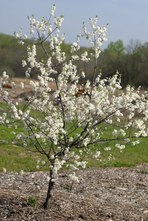Alternatives to Autumn Olive (landscapes)
Autumn olive (and the closely-related Russian olive) is an invasive species that arrived in North America with the best intentions; conservation organizations recommended planting it for wildlife. Unfortunately, it now dominates fallow fields, feeding birds berries that are like sugar pills instead of supporting the insect life that those same birds need to raise a nest full of young! As you’re removing these shrubs from your landscape and around your home, here are a few native options that we recommend as alternatives--but the sky’s the limit!
You can also download this page as a printable PDF.
You can also download this page as a printable PDF.
Shrubs: Plants that look & grow like autumn olive
|
Buffaloberry/soapberry (Sheperdia canadensis) is in the same family as autumn olive, but it’s native to northwest lower Michigan. Like autumn olive, it has silvery leaves and twigs and bright red fruits. Autumn olive often seem tree-like, but buffaloberry is shorter and more compact. It prefers sunny areas with sandy soil, though it is hardy to many conditions. Birds eat the fruits, and its early spring flowers are especially important to spring pollinators. Humans find buffaloberry fruits very bitter.
Photo: Louis M. Landry |
|
Wild plum (Prunus americana) is similar to autumn olive in its growth and bloom time: a small tree or large shrub that blooms with showy bright white flowers in May. Wild plum bears sweet, reddish-orange fruit in late summer. Like autumn olive, wild plum has a spreading root system that can help stabilize shady hills or stream banks. Pollinators love the blooms and birds and mammals (especially foxes!) adore the fruits.
Photo: Powell Gardens |
|
Staghorn sumac (Rhus typhina) is a medium-sized shrub with a unique look—most of its leaves are on the top of the plant, making an umbrella-like top. It spreads through its roots, especially in dry sandy areas, and can help control erosion. Its fall clusters of bright red fruits are highly prized by birds in winter, and its fall foliage is spectacularly scarlet.
Photo: Jordi Chueca |
|
American hazelnut (Corylus americana) bears nuts instead of fleshy fruits, but wildlife of all sorts just go crazy for them! Uneaten nuts (if there are any!) with their attractive “lacy bonnet” of leafy bracts are also less messy than squishy fruits. Hazelnut shrubs are a great replacement for autumn olive, as this native forms clonal patches, keeping soils in place and providing cover for wildlife. This shrub is very tolerant of most sun, shade, and soil conditions.
Photos: Cranbrook Institute of Science, Superior National Forest |
Other Shrub Ideas: Red and white oaks (Quercus rubra, Q. alba), New Jersey tea (Ceanothus americanus), low blueberry (Vaccinium angustifolium), red-osier dogwood (Corunus stolonifera)
Perennials: Plants that will die back each year and start over, and often stay a little smaller
|
Common milkweed (Asclepias syriaca) is a host of monarch butterfly caterpillars and a hardy perennial in nearly any sunny spot. Its sweet-scented summer flowers attract many pollinators and the foliage supports the caterpillars of more than just monarchs. Though it’s unlikely to crowd out other plants, it does like to spread into new areas.
Photo: K. Grzesiak |
|
Wild lupine (Lupinis perennis) is one of the few wildflowers that can stand up to spotted knapweed, another invasive species commonly found with autumn olive. Its bright blue-purple flowers are an elegant focal point for much of the summer, and its unique leaves provide interest throughout the growing season. It thrives in sun and dry sandy soils, but can handle shadier spots and more moisture. It attracts many pollinators, and is the host plant for the endangered Karner blue butterfly’s caterpillars.
Photo: Mark Funk |
Grasses: Change it up; you’re not limited to showy-flowering plants! Grasses are great habitat.
|
Little bluestem (Schizachyrium scoparium) is a native grass that stays a little taller than knee-high and grows in neat clumps. In fall, these clumps are stunning, turning suddenly bronze-red with frost and feeding birds throughout winter with their feathery seeds. Little bluestem prefers full sun, but, like autumn olive, tolerates drought, rocky soil, and even deer.
Photo: Drew Avery |
|
Big bluestem (Andropogon gerardii) also grows in tidy clumps, but becomes quite tall. It’s also good at self-seeding, making it ideal for spreading to protect areas from erosion. Its extensive root system allows it to withstand drought, and it loves dry, full-sun areas. The nondescript flowers offer a reddish mist over the plant in summer. Songbirds like the seeds, and the caterpillars of many butterflies and moths depend on this plant, supporting songbird nestlings too!
Photo: Matt Lavin |








